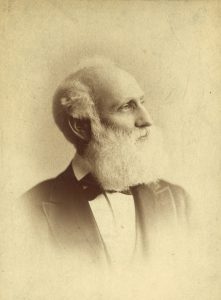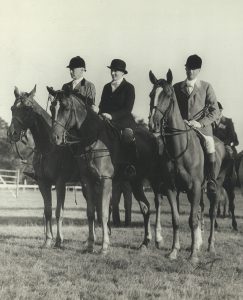Many of us have bunches of old family letters set aside to review – preferably with the sender and the recipient already noted on the envelope. Years ago, as I was researching my first family history (The Sarsaparilla Kings[1]), I was fortunate enough to have some published (as well as unpublished) sources available to consider the relationship between my great-great-grandfather Frederick Ayer (1822–1918) – one of the two Sarsaparilla Kings – and his son-in-law George Smith Patton Jr. (1885–1945).
Frederick Ayer made two distinct fortunes – in patent medicines with his elder brother, Dr. J. C. Ayer, and in textiles and other investments later in life – and by the turn of the twentieth century he was a wealthy man. His second wife, Ellen Barrows Banning (1853–1918), was a member of a sprawling family with connections in Delaware, Minnesota, and California, among them to the family of George and Ruth Patton of San Gabriel, California. (The senior George Patton was the half-brother of the wife of Mrs. Ayer’s brother-in-law’s brother and first cousin...)
Bea Ayer and Georgie Patton were contemporaries and family connections, and they grew up together during the summers when the Ayers visited California. When Patton came East to Virginia Military Institute and then West Point, the Ayer family constituted themselves his local hosts, in loco parentis. Their courtship was watched over by benevolent senior family members, and in December 1908 – in the library of the Ayers’ house in Boston – they became engaged. The setting, as Patton told his future father-in-law, was “as near neutral ground as I could get.”[2]
"All they want to do is to live happily until they die. Now if I should live that way I should die all through life..."
Writing to his own father, Patton – who struggled with spelling, and was likely dyslexic – contrasted his views with those of the Ayer family: “It is strange those people cant understand ambition except to get rich and actually I dont believe they give much of a dam about that even. All they want to do is to live happily until they die. Now if I should live that way I should die all through life…” His fiancée did not share her parents’ aspirations, for somehow Beatrice had “got the idea that I thought she wanted me to resign [from the Military Academy] on her account so she said ‘A woman who hampers a man at the beginning of his career is a hateful abomination, and he always thinks so sooner or later. So you had best not consider me at all in making your decision. The family might not thank me for telling you this but I think it… A girl might just ruin a man’s life by upsetting it at the beginning. You can decide better if you consider yourself as one instead of as two. You must decide on your own and then I will go with you any where.’”[3]
Frederick Ayer had already opened the Ayer family campaign on the subject, writing of his admiration at “the delicate manner in which” Patton had courted and proposed to Beatrice before adding “A man in the army must develop mainly in one direction, always feel unsettled… A man like you should be independent of such control – His own master – Free to act and develop in the open world. I would compare the military man to a tree grown in the forest – as against one in the field with plenty of room to spread!”[4]
A day after he wrote to his father, Patton wrote Beatrice’s father: “I have had no experience but from what I read of successful men they seem to be of the one idea sort… It is hard to answer inteligibly the question of ‘Why I want to be a soldier.’ For my own satisfaction I have tried to give my self reasons but have never found any logical ones. I only feel it inside. It is as natural for me to be a soldier as it is to breathe and would be as hard to give up all thought of it as it would be to stop breathing.”[5]
"[From] what I read of successful men they seem to be of the one idea sort..."
In 1909, Frederick Ayer was 86 and accustomed to having his way. George Patton was only 23 – but he, as we know, was a formidable man in his own right, with the active support of his future bride in this early crisis in their adult lives. Army Lieutenant George Smith Patton Jr. and Beatrice Banning Ayer were married in May 1910, and while their married life was not cloudless, the Ayer family wholly embraced Patton’s choice of career.
Several years later, when he was 93, Frederick wrote Patton that “I am trying to think of words to express my feelings and admiration of your courage and bravery, and our joy that you came away alive” from a skirmish on the Mexican border.”[6] As for Patton, when his father-in-law died in 1918 George wrote Beatrice enclosing a condolence letter from General John J. Pershing with the comment that it was the “last tribute of the greatest American soldier to the greatest American civilian.”[7]
These letters, with their quaint misspellings and generous sentiments, are to be treasured not just because they shed light on the development of a famous American general, but as illustrating the dynamics between three strong personalities: Patton, his future wife, and her father. One would not want to trifle with any one of them!
Notes
[1] Scott C. Steward, The Sarsaparilla Kings: A Biography of Dr. James Cook Ayer and Frederick Ayer, with a record of their family (Cambridge, Mass., 1993). A version of this account appears at 40–41.
[2] Letter from George S. Patton Jr. to Frederick Ayer, 3 January 1909. Martin Blumenson, The Patton Papers 1885–1940 (Boston: Houghton Mifflin Company, 1972), 157.
[3] Letter from George S. Patton to George S. Patton, 17 January 1909. Blumenson, The Patton Papers 1885–1940, 160–61.
[4] Letter from Frederick Ayer to George S. Patton Jr. [10] January 1909. Blumenson, The Patton Papers 1885–1950, 157.
[5] Letter from George S. Patton Jr. to Frederick Ayer, 18 January 1909. Blumenson, The Patton Papers 1885–1940, 162–63.
[6] Letter from Frederick Ayer to George S. Patton Jr., 31 May 1916. Blumenson, The Patton Papers, 1885–1940, 339.
[7] Letter from George S. Patton Jr. to Beatrice Ayer Patton, 27 March 1918. Blumenson, The Patton Papers, 1885–1940, 510.
Share this:
About Scott C. Steward
Scott C. Steward has been NEHGS’ Editor-in-Chief since 2013. He is the author, co-author, or editor of genealogies of the Ayer, Le Roy, Lowell, Saltonstall, Thorndike, and Winthrop families. His articles have appeared in The New England Historical and Genealogical Register, NEXUS, New England Ancestors, American Ancestors, and The Pennsylvania Genealogical Magazine, and he has written book reviews for the Register, The New York Genealogical and Biographical Record, and the National Genealogical Society Quarterly.View all posts by Scott C. Steward →

